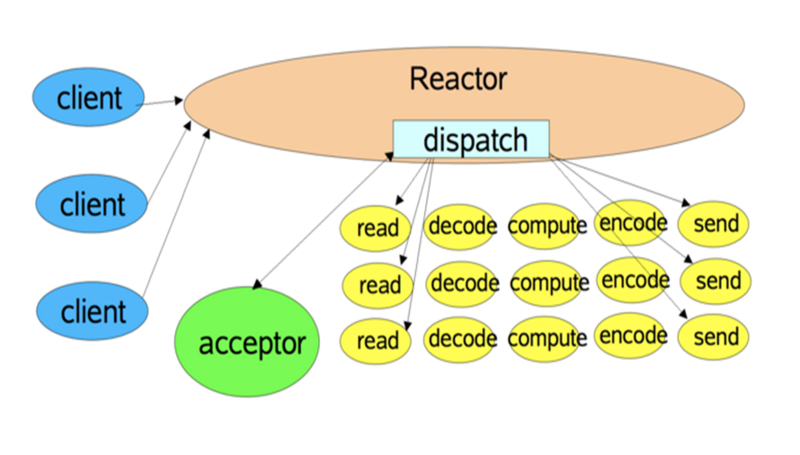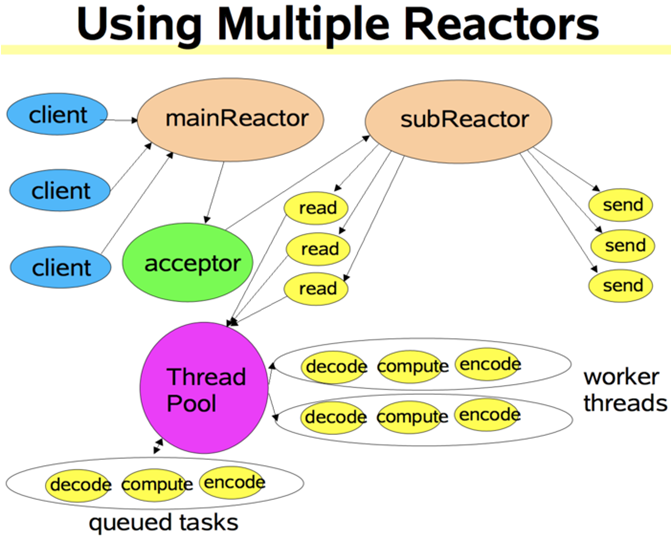NIO之Reactor模式,Netty序章
Reactor模式
反应堆模式:“反应”器名字中”反应“的由来:
- “反应”即“倒置”,“控制逆转”,具体事件处理程序不调用反应器,而向反应器注册一个事件处理器,表示自己对某些事件感兴趣,有时间来了,具体事件处理程序通过事件处理器对某个指定的事件发生做出反应。
单线程Reactor模式流程:

- ①服务器端的Reactor是一个线程对象,该线程会启动事件循环,并使用Selector(选择器)来实现IO的多路复用。channel注册一个Acceptor事件处理器到Reactor中,Acceptor事件处理器所关注的事件是ACCEPT事件,这样Reactor会监听客户端向服务器端发起的连接请求事件(ACCEPT事件)。
- ②客户端向服务器端发起一个连接请求,Reactor监听到了该ACCEPT事件的发生并将该ACCEPT事件派发给相应的Acceptor处理器来进行处理。Acceptor处理器通过accept()方法得到与这个客户端对应的连接(SocketChannel),然后将该连接所关注的READ事件以及对应的READ事件处理器注册到Reactor中,这样一来Reactor就会监听该连接的READ事件了。
- ③当Reactor监听到有读或者写事件发生时,将相关的事件派发给对应的处理器进行处理。比如,读处理器会通过SocketChannel的read()方法读取数据,此时read()操作可以直接读取到数据,而不会堵塞与等待可读的数据到来。
- ④每当处理完所有就绪的感兴趣的I/O事件后,Reactor线程会再次执行select()阻塞等待新的事件就绪并将其分派给对应处理器进行处理。
注意,Reactor的单线程模式的单线程主要是针对于I/O操作而言,也就是所有的I/O的accept()、read()、write()以及connect()操作都在一个线程上完成的。
基于单线程反应器模式手写一个NIO通信
服务端处理器:
/**
* 类说明:nio通信服务端处理器
*/
public class NioServerHandle implements Runnable{
private Selector selector;
private ServerSocketChannel serverChannel;
private volatile boolean started;
/**
* 构造方法
* @param port 指定要监听的端口号
*/
public NioServerHandle(int port) {
try {
selector = Selector.open();
serverChannel = ServerSocketChannel.open();
serverChannel.configureBlocking(false);
serverChannel.socket().bind(new InetSocketAddress(port));
serverChannel.register(selector,SelectionKey.OP_ACCEPT);
started = true;
System.out.println("服务器已启动,端口号:"+port);
} catch (IOException e) {
e.printStackTrace();
}
}
public void stop(){
started = false;
}
@Override
public void run() {
//循环遍历selector
while(started){
try{
//阻塞,只有当至少一个注册的事件发生的时候才会继续.
selector.select();
Set<SelectionKey> keys = selector.selectedKeys();
Iterator<SelectionKey> it = keys.iterator();
SelectionKey key = null;
while(it.hasNext()){
key = it.next();
it.remove();
try{
handleInput(key);
}catch(Exception e){
if(key != null){
key.cancel();
if(key.channel() != null){
key.channel().close();
}
}
}
}
}catch(Throwable t){
t.printStackTrace();
}
}
//selector关闭后会自动释放里面管理的资源
if(selector != null)
try{
selector.close();
}catch (Exception e) {
e.printStackTrace();
}
}
private void handleInput(SelectionKey key) throws IOException{
if(key.isValid()){
//处理新接入的请求消息
if(key.isAcceptable()){
//获得关心当前事件的channel
ServerSocketChannel ssc = (ServerSocketChannel)key.channel();
//通过ServerSocketChannel的accept创建SocketChannel实例
//完成该操作意味着完成TCP三次握手,TCP物理链路正式建立
SocketChannel sc = ssc.accept();
System.out.println("======socket channel 建立连接" );
//设置为非阻塞的
sc.configureBlocking(false);
//连接已经完成了,可以开始关心读事件了
sc.register(selector,SelectionKey.OP_READ);
}
//读消息
if(key.isReadable()){
System.out.println("======socket channel 数据准备完成," +
"可以去读==读取=======");
SocketChannel sc = (SocketChannel) key.channel();
//创建ByteBuffer,并开辟一个1M的缓冲区
ByteBuffer buffer = ByteBuffer.allocate(1024);
//读取请求码流,返回读取到的字节数
int readBytes = sc.read(buffer);
//读取到字节,对字节进行编解码
if(readBytes>0){
//将缓冲区当前的limit设置为position=0,
// 用于后续对缓冲区的读取操作
buffer.flip();
//根据缓冲区可读字节数创建字节数组
byte[] bytes = new byte[buffer.remaining()];
//将缓冲区可读字节数组复制到新建的数组中
buffer.get(bytes);
String message = new String(bytes,"UTF-8");
System.out.println("服务器收到消息:" + message);
//处理数据
String result = response(message) ;
//发送应答消息
doWrite(sc,result);
}
//链路已经关闭,释放资源
else if(readBytes<0){
key.cancel();
sc.close();
}
}
}
}
//发送应答消息
private void doWrite(SocketChannel channel,String response)
throws IOException {
//将消息编码为字节数组
byte[] bytes = response.getBytes();
//根据数组容量创建ByteBuffer
ByteBuffer writeBuffer = ByteBuffer.allocate(bytes.length);
//将字节数组复制到缓冲区
writeBuffer.put(bytes);
//flip操作
writeBuffer.flip();
//发送缓冲区的字节数组
channel.write(writeBuffer);
}
}
public class NioServer {
private static NioServerHandle nioServerHandle;
public static void start(){
if(nioServerHandle !=null)
nioServerHandle.stop();
nioServerHandle = new NioServerHandle(DEFAULT_PORT);
new Thread(nioServerHandle,"Server").start();
}
public static void main(String[] args){
start();
}
}
客户端处理器:
public class NioClientHandle implements Runnable{
private String host;
private int port;
private Selector selector;
private SocketChannel socketChannel;
private volatile boolean started;
public NioClientHandle(String ip, int port) {
this.host = ip;
this.port = port;
try {
//创建选择器
selector = Selector.open();
//打开通道
socketChannel = SocketChannel.open();
//如果为 true,则此通道将被置于阻塞模式;
// 如果为 false,则此通道将被置于非阻塞模式
socketChannel.configureBlocking(false);
started = true;
} catch (IOException e) {
e.printStackTrace();
}
}
public void stop(){
started = false;
}
@Override
public void run() {
try {
doConnect();
} catch (IOException e) {
e.printStackTrace();
System.exit(1);
}
//循环遍历selector
while(started){
try {
//阻塞,只有当至少一个注册的事件发生的时候才会继续
selector.select();
//获取当前有哪些事件可以使用
Set<SelectionKey> keys = selector.selectedKeys();
//转换为迭代器
Iterator<SelectionKey> it = keys.iterator();
SelectionKey key = null;
while(it.hasNext()){
key = it.next();
it.remove();
try {
handleInput(key);
} catch (IOException e) {
e.printStackTrace();
if(key!=null){
key.cancel();
if(key.channel()!=null){
key.channel().close();
}
}
}
}
} catch (IOException e) {
e.printStackTrace();
}
}
//selector关闭后会自动释放里面管理的资源
if(selector!=null){
try {
selector.close();
} catch (IOException e) {
e.printStackTrace();
}
}
}
//具体的事件处理方法
private void handleInput(SelectionKey key) throws IOException{
if(key.isValid()){
//获得关心当前事件的channel
SocketChannel sc = (SocketChannel)key.channel();
if(key.isConnectable()){//连接事件
if(sc.finishConnect()){}
else{System.exit(1);}
}
//有数据可读事件
if(key.isReadable()){
//创建ByteBuffer,并开辟一个1M的缓冲区
ByteBuffer buffer = ByteBuffer.allocate(1024);
//读取请求码流,返回读取到的字节数
int readBytes = sc.read(buffer);
//读取到字节,对字节进行编解码
if(readBytes>0){
//将缓冲区当前的limit设置为position,position=0,
// 用于后续对缓冲区的读取操作
buffer.flip();
//根据缓冲区可读字节数创建字节数组
byte[] bytes = new byte[buffer.remaining()];
//将缓冲区可读字节数组复制到新建的数组中
buffer.get(bytes);
String result = new String(bytes,"UTF-8");
System.out.println("accept message:"+result);
}else if(readBytes<0){
key.cancel();
sc.close();
}
}
}
}
//发送消息
private void doWrite(SocketChannel channel,String request)
throws IOException {
//将消息编码为字节数组
byte[] bytes = request.getBytes();
//根据数组容量创建ByteBuffer
ByteBuffer writeBuffer = ByteBuffer.allocate(bytes.length);
//将字节数组复制到缓冲区
writeBuffer.put(bytes);
//flip操作
writeBuffer.flip();
//发送缓冲区的字节数组
channel.write(writeBuffer);
}
private void doConnect() throws IOException {
/*如果此通道处于非阻塞模式,
则调用此方法将启动非阻塞连接操作。
如果立即建立连接,就像本地连接可能发生的那样,则此方法返回true。
否则,此方法返回false,
稍后必须通过调用finishConnect方法完成连接操作。*/
if(socketChannel.connect(new InetSocketAddress(host,port))){}
else{
//连接还未完成,所以注册连接就绪事件,向selector表示关注这个事件
socketChannel.register(selector,SelectionKey.OP_CONNECT);
}
}
//写数据对外暴露的API
public void sendMsg(String msg) throws Exception{
socketChannel.register(selector,SelectionKey.OP_READ);
doWrite(socketChannel,msg);
}
}
public class NioClient {
private static NioClientHandle nioClientHandle;
public static void start(){
if(nioClientHandle !=null)
nioClientHandle.stop();
nioClientHandle = new NioClientHandle(DEFAULT_SERVER_IP,DEFAULT_PORT);
new Thread(nioClientHandle,"Client").start();
}
//向服务器发送消息
public static boolean sendMsg(String msg) throws Exception{
nioClientHandle.sendMsg(msg);
return true;
}
public static void main(String[] args) throws Exception {
start();
System.out.println("请输入请求信息:");
Scanner scanner = new Scanner(System.in);
while(NioClient.sendMsg(scanner.next()));
}
}
服务端过程:
- 启动服务端,完成一些初始化工作,ServerSocketChannel绑定端口并且注册接受连接事件.
- 循环里selector.select()阻塞,只有当至少一个注册的事件发生的时候才会继续,循环里面处理发生的注册事件
- 注册事件发生时交给处理器,若为接受连接则accept取出socketChannel并完成连接,然后就是关注read读取事件即注册,有数据读取了则处理器读取请求数据并返回.
客户端过程:
- 启动客户端,完成一些初始化工作.
- 根据服务端ip及端口发起连接.
- 往服务端发送数据,并注册read读取事件
- 循环里selector.select()阻塞,只有当至少一个注册的事件发生的时候才会继续,循环里面处理发生的注册事件.
- 注册事件发生时交给处理器,若为连接事件并且连接成功则跳过即不予处理等待读取事件发送.
初始化工作如打开selector,channel,设置通道模式是否阻塞.
单线程Reactor,工作者线程池
但在单线程Reactor模式中,不仅I/O操作在该Reactor线程上,连非I/O的业务操作也在该线程上进行处理了,这可能会大大延迟I/O请求的响应。所以我们应该将非I/O的业务逻辑操作从Reactor线程上卸载,以此来加速Reactor线程对I/O请求的响应.

添加了一个工作者线程池,并将非I/O操作从Reactor线程中移出转交给工作者线程池来执行。这样能够提高Reactor线程的I/O响应,不至于因为一些耗时的业务逻辑而延迟对后面I/O请求的处理。
改进的版本中,所以的I/O操作依旧由一个Reactor来完成,包括I/O的accept()、read()、write()以及connect()操作。
对于一些小容量应用场景,可以使用单线程模型。但是对于高负载、大并发或大数据量的应用场景却不合适,主要原因如下:
- ① 一个NIO线程同时处理成百上千的链路,性能上无法支撑,即便NIO线程的CPU负荷达到100%,也无法满足海量消息的读取和发送;
- ②当NIO线程负载过重之后,处理速度将变慢,这会导致大量客户端连接超时,超时之后往往会进行重发,这更加重了NIO线程的负载,最终会导致大量消息积压和处理超时,成为系统的性能瓶颈;
多Reactor线程模式

Reactor线程池中的每一Reactor线程都会有自己的Selector、线程和分发的事件循环逻辑。
mainReactor可以只有一个,但subReactor一般会有多个。mainReactor线程主要负责接收客户端的连接请求,然后将接收到的SocketChannel传递给subReactor,由subReactor来完成和客户端的通信。
流程:
- ①注册一个Acceptor事件处理器到mainReactor中,Acceptor事件处理器所关注的事件是ACCEPT事件,这样mainReactor会监听客户端向服务器端发起的连接请求事件(ACCEPT事件)。启动mainReactor的事件循环。
- ②客户端向服务器端发起一个连接请求,mainReactor监听到了该ACCEPT事件并将该ACCEPT事件派发给Acceptor处理器来进行处理。Acceptor处理器通过accept()方法得到与这个客户端对应的连接(SocketChannel),然后将这个SocketChannel传递给subReactor线程池。
- ③subReactor线程池分配一个subReactor线程给这个SocketChannel,即,将SocketChannel关注的READ事件以及对应的READ事件处理器注册到subReactor线程中。当然你也注册WRITE事件以及WRITE事件处理器到subReactor线程中以完成I/O写操作。Reactor线程池中的每一Reactor线程都会有自己的Selector、线程和分发的循环逻辑。
- ④当有I/O事件就绪时,相关的subReactor就将事件派发给响应的处理器处理。注意,这里subReactor线程只负责完成I/O的read()操作,在读取到数据后将业务逻辑的处理放入到线程池中完成,若完成业务逻辑后需要返回数据给客户端,则相关的I/O的write操作还是会被提交回subReactor线程来完成。
注意,所以的I/O操作(包括,I/O的accept()、read()、write()以及connect()操作)依旧还是在Reactor线程(mainReactor线程 或 subReactor线程)中完成的。Thread Pool(线程池)仅用来处理非I/O操作的逻辑。
多Reactor线程模式将“接受客户端的连接请求”和“与该客户端的通信”分在了两个Reactor线程来完成。mainReactor完成接收客户端连接请求的操作,它不负责与客户端的通信,而是将建立好的连接转交给subReactor线程来完成与客户端的通信,这样一来就不会因为read()数据量太大而导致后面的客户端连接请求得不到即时处理的情况。并且多Reactor线程模式在海量的客户端并发请求的情况下,还可以通过实现subReactor线程池来将海量的连接分发给多个subReactor线程,在多核的操作系统中这能大大提升应用的负载和吞吐量。
Netty服务端使用了“多Reactor线程模式”











![[HBLOG]公众号](https://www.liuhaihua.cn/img/qrcode_gzh.jpg)

